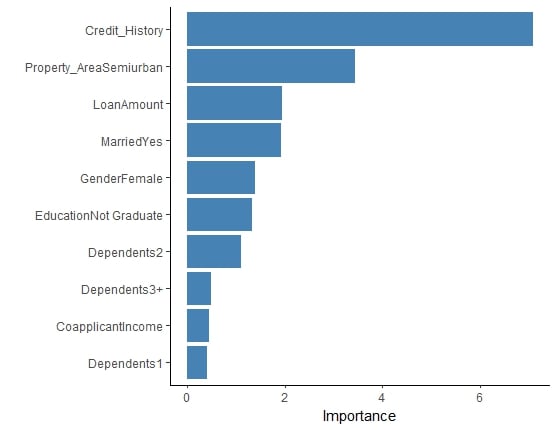Reducing the model's features
Feature Engineering in R

Jorge Zazueta
Research Professor and Head of the Modeling Group at the School of Economics, UASLP
Reasons to reduce the number of features
Eliminating irrelevant or low-information variables can have benefits, including
- Reduce model variance without significantly increasing bias
- Increase out-of-sample model performance
- Reducing computation time
- Decreasing model complexity
- Improving interpretability
Sifting data through variable importance
Fitting a model with all features
lr_recipe_full <-
recipe(Loan_Status ~., data = train) %>%
update_role(Loan_ID, new_role = "ID")
lr_workflow_full <-
workflow() %>%
add_model(lr_model) %>%
add_recipe(lr_recipe_full)
lr_fit_full <-
lr_workflow_full %>%
fit(data = train)
Graphing variable vip
lr_fit_full %>%
extract_fit_parsnip() %>%
vip(aesthetics = list(fill = "steelblue"))
Variable importance

Build a reduced model using the formula syntax
We can add features directly by using the basic R formula syntax.
# Create recipe
recipe_formula <-
recipe(Loan_Status ~ Credit_History + Property_Area +
LoanAmount, data = train)
# Bundle with model
workflow_formula <- # Bundle with model
workflow() %>% add_model(lr_model) %>%
add_recipe(recipe_formula)
Build a reduced model by creating a features vector
A feature vector can be passed used to select features before training.
# Feature vector
features <- c("Credit_History", "Property_Area", "LoanAmount", "Loan_Status")
# Training and testing data
train_features <- train %>% select(all_of(features))
test_features <- test %>% select(all_of(features))
# Create recipe and bundle with model
recipe_features <- recipe(Loan_Status ~., data = train_features)
workflow_features <- workflow() %>% add_model(lr_model) %>%
add_recipe(recipe_features)
Creating the augmented objects
Augmented objects for both approaches
lr_aug_formula <-
workflow_formula %>%
fit(data = train) %>%
augment(new_data = test)
lr_aug_features <-
workflow_features %>%
fit(data = train_features) %>%
augment(new_data = test_features)
Both ways return the same results
all_equal(lr_aug_features,
lr_aug_formula %>%
select(all_of(features),
starts_with(".pred")))
[1] TRUE
Comparing the full and reduced models
Using all features
lr_fit_full <- # Fit workflow
lr_workflow_full %>%
fit(data = train)
lr_aug_full <- # Augment
lr_fit_full %>%
augment(test)
lr_aug_full %>% # Evaluate
class_evaluate(truth = Loan_Status,
estimate = .pred_class,
.pred_Y)
# A tibble: 2 × 3
.metric .estimator .estimate
<chr> <chr> <dbl>
1 accuracy binary 0.842
2 roc_auc binary 0.744
Using top 3 features*
lr_fit_formula <- # Fit workflow
workflow_formula %>%
fit(train)
lr_aug_formula <- # Augment
lr_fit_formula %>%
augment(new_data = test)
lr_aug_formula %>% # Evaluate
class_evaluate(truth = Loan_Status,
estimate = .pred_class,
.pred_Y)
# A tibble: 2 × 3
.metric .estimator .estimate
<chr> <chr> <dbl>
1 accuracy binary 0.842
2 roc_auc binary 0.733
Let's practice!
Feature Engineering in R

